Silk Road Facts and History
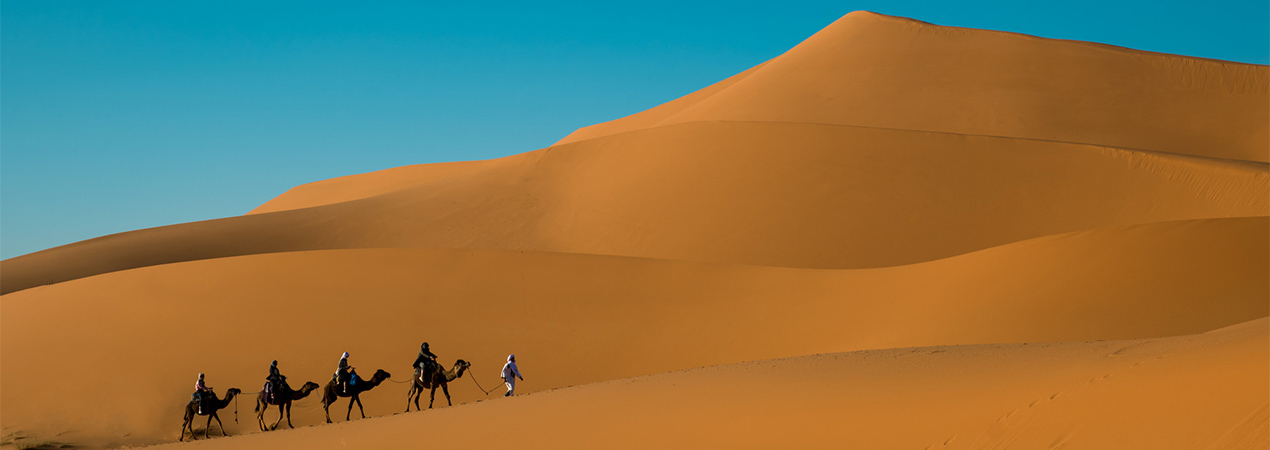
The Silk Road, or Silk Route, was a trade network frequented from about the 1st century CE to the 15th century which linked far-flung regions of the ancient world in commerce. It was not an actual road, but a shifting path connecting a series of trade stops, villages, and cities, through which merchants would pass. It was on the Silk Roads that East and West first encountered each other through trade and conquest, leading to the spread of ideas, cultures and religions. From the rise and fall of empires to the spread of Buddhism and the advent of Christianity and Islam, right up to the great wars of the twentieth century, the Silk Road was just like a theater, the main characters were pilgrims, merchants, soldiers, and nomads.
The Silk Roads continue to capture the imagination of the public, and, in 2014, a section of the land routes (the Routes Network of Chang'an-Tianshan Corridor) was designated a World Heritage Site by UNESCO. Yet there was no single "Silk Road." Instead, a complex network of trade routes spanned Afro-Eurasia’s mountains, plains, deserts, and seas. The Marine Silk Route is one of the oldest silk routes existing in the world. The combined system of the marine system and roadways made these routes the most important pathways for the silk trade. Later, they also went on to open gates for trade of other commodities as well.
Facts:
We have listed answers for 10 of the most frequently asked questions about the Silk Road below:
1. Who first used the term “Silk Road”?
The German geographer and traveler Ferdinand von Richthofen first used the term “silk road” in 1877 C.E. to describe the well-traveled pathway of goods between Europe and East Asia. He was a prominent geographer who worked in China from 1868 to 1872 surveying coal deposits and ports, and then wrote a five-volume atlas that used the term for the first time.
His student, the renowned Swedish geographer and explorer Sven Hedin, published a book entitled The Silk Road in 1934; the book is about his China expeditions in the early 1900s. Historians now prefer the term “Silk Routes,” which more accurately reflects the fact that there was more than one thoroughfare.
2. Why was the Silk Road important?
The Silk Road was important because it helped to generate trade and commerce between east and west. More importantly, it helped ideas, culture, inventions, and unique products to spread across the world.
3. How did the Silk Road change the world?
Since the Silk Road connected people from different cultures, languages, and religions, there was an astounding exchange of ideas within and between these cities. Religious ideologies such as Zoroastrianism, Christianity, Islam, and Buddhism disseminated along the Silk Road. Buddhism spread out of the Indian subcontinent along the Silk Roads into China in the first century BCE. Buddhism affected every aspect of Chinese society. Technological developments and inventions also made their way along the Silk Road. The most important inventions are paper and gunpowder, both invented by the Chinese during the Han Dynasty, and which have had obvious and lasting impacts on culture and history in the West.
Unfortunately, not everything that traveled across the Silk Road was good. According to Science Magazine, trade from the Silk Road most likely introduced the bubonic plague (commonly known as Black Death) into Europe in 1346 CE, which led to the death of almost half of all Europeans within seven years.
4. Besides silk, what other things were traded on the Silk Road?
Caravans heading towards the east were laden with gold, silver, ivory, gems and glass. Foods such as pomegranates and carrots were also traded, while from the opposite direction came tea, porcelain, jade, paper, fur and spices. Compared with these tangible goods, the exchanges of language, culture, religious beliefs, philosophy and science on the road are more important.
5. Is there a maritime Silk Road?
Yes, there is, as a great deal of travel and trade also occurred by sea. It was also known as ‘The Spice Routes’. This famous trade thoroughfare had two prominent routes that were frequented by merchants and traders. They were the East China Sea route and the South China Sea route. The East China Sea route headed to Japan and Korea. The South China Sea route went to South East Asia, Malacca, the Indian Ocean, the Red Sea and Africa. The maritime route was well known for trading in iron, silk, brass, and fine china from China, and they, in turn, got spices, plants and flowers, and unique treasures for their royalty. The most famous maritime Silk Road voyages were made by Zheng He. The eunuch admiral, a Muslim at the Ming court, led seven voyages in the period 1405 to 1433 in a fleet of vast sailing barges known as “treasure ships”. He commanded his fleets into Southeast Asia, India, the Middle East and Eastern Africa. He and his convoy engaged in commerce with many different kinds of people. Back came fabulous curiosities, including a giraffe, which he fashioned as a tribute to the emperor.
6. How long is the whole Silk Road?
Depending on how you measure it, the overland Silk Road extended approximately 6,440 kilometers (4,000 miles) from Chang’an (nowadays Xi’an) in China to Rome in the Roman Empire. It traversed some of the world’s most formidable landscapes, including the Gobi Desert and the Pamir Mountains.
The Maritime Silk Roads total over 15,000 kilometers (9375miles) in length, as it stretched from the west coast of Japan, through the islands of Indonesia, around India to the lands of the Middle East – and from there, across the Mediterranean to Europe.
7. What was the main method of transportation?
For the Overland Route, camels were popular animals for transport because much of the road was through dry and harsh land. Merchants and tradesmen traveled in large caravans. They would have had many guards with them. Traveling in a big group like a caravan helped in defending from bandits.
For the Maritime Route, ships are the only transportation. Like the merchants of the overland Silk Road, those who traveled along the sea route were also at the mercy of the forces of nature, especially storms that were highly unpredictable. Moreover, pirates who plied the oceans were also a threat to travelers, just as the desert bandits were for their overland counterparts.
8. Who were the famous travelers on the Road?
One of the most famous travelers of the Silk Road was Marco Polo (1254–1324 CE). Marco Polo traveled with his father and uncle to China when he was just 17. They traveled for over three years on the Silk Road before arriving at Kublai Khan’s palace at Xanadu in 1275 C.E. Marco Polo stayed on at Khan’s court and was dispatched on trips to help administer the realm. Upon his return in 1295 CE, Marco Polo wrote about his adventures, making him—and the routes he traveled—famous. Christopher Columbus purportedly sailed to the New World with a copy of Marco Polo’s “Travels” in tow. Another famous traveler is Xuanzang (602 – 664CE). He took a 17-year pilgrimage to bring Buddhist teachings from India to China. He traveled along what we now know as the Silk Road. He survived the dangerous Taklamakan Desert and continued through the high and harsh mountains of Tian Shan (literally, mountains of the heavens). Following his journey, Buddhism became more prevalent and more widely understood in China and subsequently elsewhere in the world. Xuanzang is a household name in China as his journey to India inspired the great Chinese epic Journey to the West (also known as ‘The Legend of the Monkey King’).
9. Why did the Silk Road decline?
The Ottoman Turk seized Constantinople in 1453 CE and controlled the Silk Road, so Europeans could trade through Constantinople but they had to pay high taxes. The discovery of a sea route from Europe to Asia in the late 15th century dealt a damaging blow to the Silk Road trade. With less cost, harassment and danger, many goods and materials that the Silk Road could not transfer were conveyed through the sea route.
10. What is China’s Belt and Road Initiative (BRI)?
China’s Belt and Road Initiative (BRI) is a strategy initiated by China that seeks to connect Asia with Africa and Europe via land and maritime networks. It aims to improve regional integration, increasing trade and stimulating economic growth. The name was coined in 2013 by China’s President Xi Jinping, who drew inspiration from the concept of the ancient Silk Road established during the Han Dynasty 2,000 years ago. The BRI refers to 'One Belt One Road'. The BRI comprises a Silk Road Economic Belt – a trans-continental passage that links China with south east Asia, south Asia, central Asia, Russia and Europe by land – and a 21st century Maritime Silk Road, a sea route connecting China’s coastal regions with south east and south Asia, the South Pacific, the Middle East and Eastern Africa, all the way to Europe.
History of the Silk Road
2013
China proposed the Belt and Road Initiative (BRI) to improve connectivity and cooperation on a transcontinental scale.
1877
German geographer and traveler Ferdinand von Richthofen coined the term "Silk Road" to describe the route that connects east and west.
1453
The fall of Constantinople (modern day Istanbul, Turkey) to the Ottomans ended the 1,500 year Roman empire. The Ottomans controlled the Silk Road and charged high taxes that caused the decline of the route.
1275
Marco Polo arrived in China via the Silk Road. He spent three years on the road and the experience was recorded in his famous travelogue.
1271
The Yuan Dynasty (Chinese portion of Mongol Empire) was founded by Kublai Khan, the grandson of Genghis Khan. Mongol conquests ushered in an era of peace and prosperity for Eurasia – a time that is known as the Pax Mongolica of the 13th and 14th centuries. Mongols always support merchants and trade, and the Silk Road was prosperous during this period.
618
The Tang Dynasty was founded; it was one of the most prosperous empires in China’s history. Its vast territory stretched to the edge of the Middle East where eastern cultures meet western cultures. Advances in technology and increased political stability caused an increase in trade. Trade was flourishing on the Silk Road during this period. Along with silk brocades and raw silks, the art of paper-making made its way to the West from China along the Silk Road.
609
Emperor Yangdi of the Sui Dynasty (581 – 618 CE) held a world expo in Zhangye, and delegations from 27 kingdoms attended this expo. A lot of different kinds of goods were traded during the expo.
455
A Persian delegation arrived in Pingcheng (modern day Datong) via the Silk Road, and they brought glassware to China.
97
Ban Chao went as far west as the Caspian Sea with 70,000 men and established direct military contacts with the Parthian Empire, also dispatching an envoy headed by Gan Ying to Rome. Although Gan Ying never reached Rome, only travelling to the Parthian coast of the Persian Gulf, he is, at least in the historical records, the Chinese who went the furthest west during antiquity, and he gathered what information he could.
76
Han Emperor Mingdi dreamed of a golden deity from west and his minister told him that it was called Buddha. The emperor sent out a mission to India to bring scriptures about this foreign deity back to China.
73 CE
Chinese general Ban Chao was dispatched with a small force on a mission to pacify the Xiongnu tribes who had been raiding China’s northwestern borders. He managed to liberate the southern route of the Silk Road from the domination of the Xiongnu.
138 BCE
Han Emperor Wudi sent imperial envoy Zhang Qian to make contact with Yuezhi to make allies to combat the Xiongnu. Zhang was captured by Xiongnu and detained for 10 years, so it was not until 127 BCE that Zhang arrived in Yuezhi. But Yuezhi people were happy with what they had so Zhang had to return to China. However Zhang’s reports from his journeys conveyed valuable information about the people and lands that lay to the West.
334 BCE
The first major step in opening the Silk Road between the East and the West came with the expansion of Alexander the Great deep into Central Asia, as far as Ferghana at the borders of the modern-day Xinjiang region of China, where he founded in 329 BCE a Greek settlement in the city of Alexandria Eschate "Alexandria The Furthest", nowadays known as Khujand in Tajikistan.

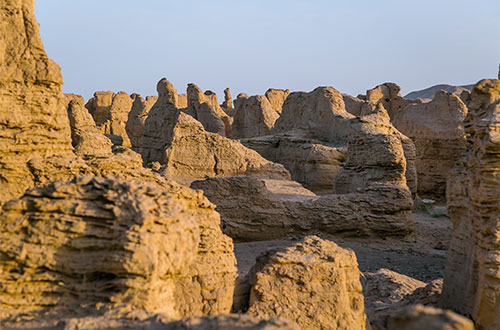 Top Destinations Along the Silk Road
Top Destinations Along the Silk Road 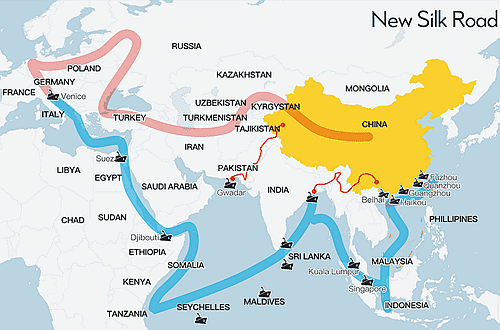 New Silk Road
New Silk Road 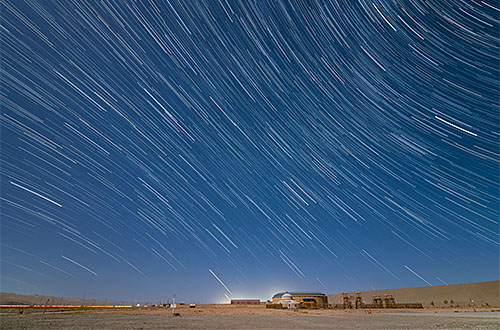 Silk Road Photography Tour
Silk Road Photography Tour 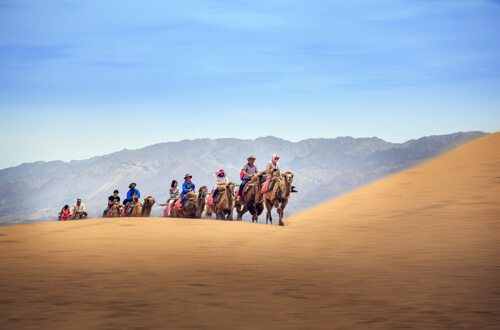 Silk Road in a Nutshell from Lanzhou to Dunhuang
Silk Road in a Nutshell from Lanzhou to Dunhuang